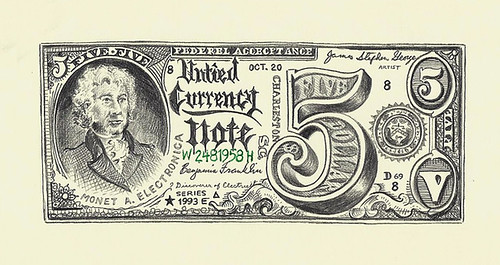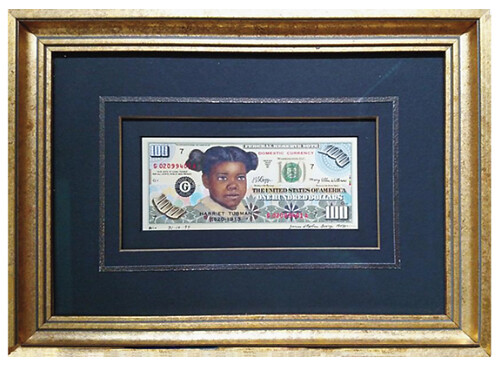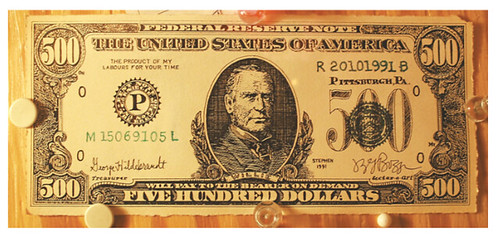
PREV ARTICLE
NEXT ARTICLE
FULL ISSUE
PREV FULL ISSUE
CONSIDERING THE CONTROVERSIAL J.S.G. BOGGS
Steve Roach's new article on Money Artist J.S.G. Boggs was published August 19, 2016 by Coin World. Thanks to Chip Howell and others who noticed it. Here's an excerpt.
-Editor
Working both within and outside of the confines of the law, American artist James Stephen George Boggs — better known as J.S.G. Boggs — is an enigma. His signature pieces are hand-drawn replicas of current money called “Boggs bills” that he uses to purchase goods and services. His work combines visual art and performance art, with his bills and the documentation of the transaction serving as a core element of his artistic practice. Boggs was born in Woodbury, N.J., in 1955 and rose to fame with his one-man exhibition titled “smart money (HARD CURRENCY)” that traveled the country. He isn’t represented by traditional galleries and his work generally has to be acquired through a transaction with the artist. This exclusivity adds to his mystique.
I spoke with Steve Roach at the recent ANA show in Anaheim and corresponded with him by email as he researched his article, which included my first Boggs acquisition.
-Editor

Homren would have the opportunity to purchase a $5 fantasy note that takes traditional elements of U.S. currency design and incorporates more personal elements, including a portrait of a man named Monet A. Electronica. The design cleverly weaves in Moneta, goddess of money, Impressionist Claude Monet and Benjamin Franklin and incorporates Boggs’ interest in the future of electronic money. Boggs personalized it by creating a serial number incorporating Homren’s initials. The completed transaction left Homren with questions: Did he offer too much (or too little), why did he buy this particular work of art and how hard is it for an artist to sell his work? As the collector concluded, these questions don’t have clear answers, and he wrote, “It won’t be just a piece of paper on my wall. It will be a reminder of a pleasant encounter and a trigger for more thoughts and questions on the nature of art, money, history and people.”
HARRIET TUBMAN AND BOGGS An article in the December/January 1995 magazine Worth by Timothy J. Sultan titled “Change for a Hundred” discusses Boggs alongside the government’s redesign of money in the 1990s to incorporate new anti-counterfeiting technologies. The magazine asked a group of artists to design a note using similar requirements to the Treasury Department’s. As the article concluded, “Along the way, we learned that strict constraints don’t limit a good artist, and that money can be beautiful, provocative, even moving. That’s only fitting. Banknotes aren’t just valuable pieces of paper. They’re national works of art.”

Boggs’s $100 Federal Reserve note depicted Harriet Tubman as a young child. Tubman escaped slavery to become a leading abolitionist and a conductor of the Underground Railroad who was personally responsible for freeing hundreds of slaves. During the Civil War, she served as a nurse, a cook, and a scout who gathered intelligence for the Union cause. He related the image to her intervention in a slave beating as a young girl, and Boggs commented, “Heroes are always depicted as mature, stately persons. Can a young black girl, or any child, identify with that?” Boggs further suggested different bills for use overseas, where the majority of fake U.S. notes circulate. On April 20, Treasury Secretary Jack Lew announced that future $5, $10 and $20 notes would feature women in their designs and that the new face on the $20 bill would be Harriet Tubman. The designs of the new Tubman bills are expected to be revealed in 2020 to coincide with the centennial of the Constitution’s 19th Amendment, which gave women the right to vote.
COLLECTING BOGGS As Homren explains, “It’s the most important one in the series because of the Worth magazine article, which he won an award for (but didn’t want, because it was a commercial art award, not a fine art award). With the Treasury choosing Tubman for the new FRN, this could become his signature work.” Homren added, “Boggs got no mention when the Treasury announced the new Tubman design. Boggs was there 20 years ago, and deserves some credit.” In a Nov. 30, 2015, auction by Numismatic Auctions LLC in Okemos, Mich., a 1991 piece titled October Rent ($500) sold for $16,100, exceeding the estimate of $7,500 to $15,000.

The framed piece included various components of a rent transaction: a $500 “Boggs bill” with a portrait of William McKinley, named Willie on the note and consistent with the artist’s practice of changing certain details or wording. Also included is the change from the rent payment — a genuine contemporary $50 Federal Reserve note — along with the original receipt signed by the landlord who accepted the bill as Boggs lived in a space called the Brew House in 1991, a brass numeral “5” of the type found on an apartment door, the store package for the numeral, a bottle cap, Lipton tea wrapper, a real estate business card, and a portion of the October calendar for that year. In the catalog, auctioneer Steven Davis wrote, “This is a wonderful and early ‘Complete Transaction’ performed by the artist,” adding, “Complete Boggs transactions are difficult to come by, let alone one featuring a $500 Boggs bill.”
Be sure to read the complete article online and click on the image at the top to see all associated artwork images. Many thanks to Coin World for including all original images on the site. The composite images like those seen at the top of the article's web page are popular today and eye-catching, but of little use for research because much of the underlying image is obscured.
-Editor
To read the complete article, see:

Wayne Homren, Editor The Numismatic Bibliomania Society is a non-profit organization promoting numismatic literature. See our web site at coinbooks.org. To submit items for publication in The E-Sylum, write to the Editor at this address: whomren@gmail.com To subscribe go to: https://my.binhost.com/lists/listinfo/esylum All Rights Reserved. NBS Home Page Contact the NBS webmaster 
|